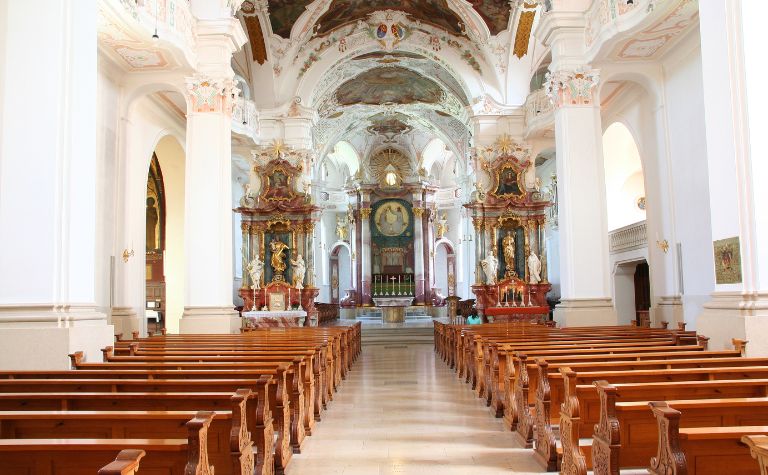“Catholic” and “Christian” are two terms commonly used to describe churches and people who follow the teachings of Jesus of Nazareth, as they are recorded in the New Testament. For many people, confusion arises regarding the similarities and differences between the terms.
Roman Catholicism is one of the three historical branches of the Christian faith, Protestantism, and Eastern Orthodoxy. There are internal debates in each tradition about whether people in the other two branches are Christians. “Christian” can refer to a person in any branch or one of them, depending on context.
Why don’t some people in other traditions consider Catholics to be Christians? Why do other non-Catholics argue that Catholics are Christians? How do Catholicism’s history and teachings generally compare with Eastern Orthodoxy and Protestant Christianity? Keep reading to learn the answers to these questions and others.
Also, see Roman Catholic vs. Protestant Christianity: What’s the Difference? to learn more.

Roman Catholicism and Christianity Compared
Some people respond to the question, “What’s the difference between Catholics and Christians?” with “But Catholics are Christians.”
For Catholics and non-Catholics who share this conviction, the question is similar to asking, “What’s the difference between apples and fruit?” Discussing the question has benefits whether a reader agrees with this response or not.
What’s the benefit of discussing the question for those who believe Catholics are Christians?
For those whose theology convinces them that Catholics are Christians, it can be helpful to understand the similarities and differences between Catholicism and other historical expressions of the Christian faith, like Eastern Orthodoxy and Protestantism.
What’s the benefit of discussing the question for those who believe Catholics aren’t Christians?
Some people in non-Catholic traditions, especially in certain expressions of Protestantism, are persuaded that the traditional teachings of the Catholic Church have replaced the Bible or added to its revelation in unorthodox ways.
Comparing Catholicism with other historic branches will help inform the accuracy of their assessment.
What about those who argue that people in other traditions have an incomplete experience?
Many members in each historic branch believe that people in the other historic traditions are Christians but that their experience of Christ and the Church is fragmentary because some of their beliefs and practices are awry.
| Christianity | Roman Catholicism | |
|---|---|---|
| Name | “Christianity” is the name of the faith of Jesus Christ, and a “Christian” is someone who follows him. “Protestant’ comes from the word “protest” and refers to the movement’s disagreements with certain Catholic doctrines. “Eastern” refers to a geographical location, and “Orthodox” refers to a true set of beliefs. | The word “Roman” is derived from the city of Rome, Italy. “Catholic” refers to the universal Church, as opposed to a local church. After a schism in the 11th century, the Catholic Church was considered “West,” and the Orthodox Church was called “East.” |
| Branch of Christianity | There are three historical branches of the Christian faith: Roman Catholicism, Protestantism, and Eastern Orthodox. Catholicism and Eastern Orthodoxy are sometimes divided into regions (e.g., Greek Orthodox). Protestantism has many traditions, including Baptist, Lutheran, and Methodist. | Roman Catholicism traces its origins to Christ, and the Apostle Peter (Matt. 16:18-19), who the church teaches was the first bishop of Rome. Other branches also trace their roots to the early church and argue that Catholicism’s unique teachings appeared centuries later. |
| Founding | The person and work of Jesus of Nazareth, whom followers identify as the Messiah or Christ, are the foundation of the Christian faith. Acts 11:26 reads, “And in Antioch, the disciples were first called Christians.” (ESV) | The first century. Catholicism teaches that its origins are the origins of the church itself, starting with Peter. The other branches trace their roots to the early church and refer to their origin as reactions to unbiblical proclamations and decisions rendered by certain popes and councils. |
| Early contributors | Jesus’ Apostles, including Paul of Tarsus, wrote 12 of the 27 books of the New Testament. Each historic branch claims the early church fathers in different ways. | The early bishops of Rome, the early church fathers, including Ignatius of Antioch (died 108 AD, according to Eusebius) and Irenaeus (130-202 AD). |
| Christianity | Roman Catholicism | |
|---|---|---|
| Membership | All branches together number around 2.5 billion people. | The Catholic Church reports a global membership of over 1.3 billion people. |
| Authority | Protestantism champions the authority of Scripture alone. Eastern Orthodoxy locates authority in Scripture and the historical teachings of their tradition. | Roman Catholicism locates authority in Scripture and the historic teaching of their tradition. |
| Social worldview today | Eastern Orthodox churches are conservative. Some mainline Protestant churches have become more liberal in recent decades. The evangelical wing of Protestantism remains devoutly conservative. | The Catholic Church is generally considered conservative in the context of the socio-political landscape of the 21st-century Western world. |
Also, see Roman Catholic vs. Eastern Orthodox: What’s the Difference? to learn more.

Roman Catholic and Christian Beliefs: Similarities and Differences
Comparing and contrasting the historical beliefs of Roman Catholicism with the broader Christian faith has strengths and weaknesses.
- On the one hand, the strength of such an assessment is that it gives readers a starting point. Sometimes it’s helpful to view the “forest” before examining each “tree” when learning more about a subject.
- On the other hand, the paramount weakness is that it’s difficult to summarize entire doctrines in just a few sentences. Nevertheless, the comparisons below are offered to those who may find them helpful to their learning.
| Christianity | Roman Catholicism | |
|---|---|---|
| View of the Bible | Most Christian traditions believe God inspired the writing of the Bible. Some have a low view of its relevance for today, and others (especially conservatives), emphasize its authority for all times, even today. Protestant Bibles don’t include the Apocrypha. Eastern Orthodox Bibles do. | The Catholic Church teaches that the Bible is the inspired Word of God. The Catholic Bible has the same books that Protestant Bibles have but also includes the deutero-canonical literature or Apocrypha, as Eastern Orthodoxy does. |
| View of God | All Christian traditions believe in the Trinity, which is so foundational that not believing in it renders a person or church decidedly not Christian. | Likewise, the Catholic Church teaches that God is Triune. The Father, Son, and Holy Spirit are each fully God. |
| View of Christ | Christian traditions are in general agreement about the person and work of Christ. All acknowledge his miraculous birth, sinless life, atoning death, and physical resurrection from the dead. There isn’t agreement about the nature of the atonement, i.e., why Christ died on the cross and what exactly his death achieved. | The Catholic Church affirms the same general beliefs about the person and work of Christ as other branches do. |
| View of Salvation | Historically, Christian traditions have agreed that Jesus is the only way a person can be saved (e.g., Acts 4:12). Traditions don’t always agree on how God saves people, i.e., the exact role that people have and the exact role that God has in the process are the subjects of discussion and debate. Protestantism teaches that salvation is by God’s grace, through a person’s faith, and in Christ alone. | Catholicism teaches that God imparts grace to people through the sacraments. Catholic teaching reflects Arminian views, though Jacob Arminius (1560-1609) was Protestant, so the church doesn’t use the same terminology as other Arminian Christians. The Catholic Church isn’t Calvinist. |
| View of the Holy Spirit | All Christian traditions are in general agreement about the person and work of the Holy Spirit, though significantly, Eastern Orthodoxy teaches that the Spirit proceeds from the Father, while others believe he proceeds from the Father and the Son. Pentecostalism is prevalent in Protestantism but is found only in smaller numbers outside of it. | The Catholic Church affirms the same general beliefs about the person and work of the Holy Spirit as Protestants. The Catholic Church encourages its members to be biblical and discerning in relation to speaking in tongues. |

Also, see Christianity vs. Mormonism: What’s the Difference? to learn more.
| Christianity | Roman Catholicism | |
|---|---|---|
| Human Leader | Protestantism rejects the office and authority of the pope. Eastern Orthodoxy recognizes the pope but doesn’t believe the office has ultimate authority, as Roman Catholicism teaches it does. | The Pope is the Vicar of Christ and the head of the Church on Earth, an office that church teaching traces to the Apostle Peter. |
| View of the Ordinances or Sacraments | Some Protestants use the term “ordinance,” while others prefer “sacrament.” Protestantism only has two, which are the ones that Christ explicitly taught: baptism and the Lord’s Supper. Eastern Orthodoxy, like Roman Catholicism, has seven. | There are seven sacraments in Catholicism: (1) adult and infant baptism, (2) confirmation, (3) the Eucharist, (4) penance, (5) anointing, (6) ordination, and (7) marriage. These practices are channels of God’s grace, according to Catholic theology. |
| View of the Lord’s Supper | There is a variety of views regarding the bread and cup in non-Catholic traditions. For example, in Protestantism, Lutheranism believes in consubstantiation, Presbyterianism believes in the Real Presence of Christ, and the Baptist tradition teaches a memorial view. Eastern Orthodoxy refers to the sacrament as a mystery and doesn’t fully embrace transubstantiation. | According to the Catholic Church, the “Eucharist,” meaning “to thank,” is “the source and summit of the Christian life.” The Eucharist is a memorial in which the bread and cup become the body and blood of Christ. The change in the nature of the elements is called transubstantiation. |
| View of the Baptism | There are a variety of perspectives about baptism among non-Catholic traditions. Some affirm infant baptism and believe it’s a means of grace. Others hold to “Believer’s Baptism,” only baptize professing adults, and don’t believe it’s a means of God’s grace. | Sometimes referred to as “paedobaptism” (paedo = “child”), children of Christian parents are baptized to cleanse them of original sin and regenerate them. |
| View of the End Times | All Christian traditions believe in the Second Coming of Christ and eternal life in heaven with God. What happens before the Second Coming is the subject of significant debate in Protestantism. Eastern Orthodoxy favors Amillennialism. | The Catholic Church affirms the Second Coming of Christ. The church’s eschatology is Amillennial. |
Also, see Roman Catholic vs. Lutheran: What’s the Difference? to learn more.
Related Questions
Catholic vs. Protestant vs. Orthodox: What's the Difference?
Roman Catholicism, Protestant Christianity, and the Eastern Orthodox Church are the three historical branches of the Christian religion. Each tradition traces its doctrines and practices to the New...
Roman Catholicism and Lutheranism, part of the Protestant tradition, are two of the most prominent branches of the Christian religion. Many people find it interesting to compare and contrast...
